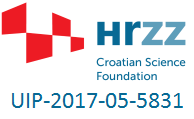 Group for Applied Ultrafast Spectroscopy and Photochemical Identification
Group for Applied Ultrafast Spectroscopy and Photochemical IdentificationAlthough atomic and molecular laser spectroscopy has long history at the Institute of Physics, it was not until recently that we started to employ ultrafast laser spectroscopy for investigation of photochemical and photophysical properties of several interesting organic molecular systems. The important milestone was acceptance of project proposal Croatian Science Foundation that enabled us to reach higher level of research.
The aim of this project is to establish a new research group that will focus on investigation of photochemical processes using ultrafast spectroscopy methods. Collaboration with other scientist working in fields of chemistry, biology, medicine etc. is expected to result in interdisciplinary research of new scientific problems. This is important, as photochemistry is one of the most influential research fields that expand our knowledge of some important processes such as: efficient energy conversion (photosynthesis), photodegradation, photopolymerization etc.
Monitoring of the ultrafast dynamics in complex molecular systems relies on pump – probe measurements with ultrashort pulses. Transient absorption (TA), one of pump-probe techniques, reveals dynamical information by watching the system evolve on the excited-state potential with time. Photo-induced processes like photodissociation, photoisomerisation, energy transfer and similar start with absorption of radiation from the pump beam. The population is then transferred to the upper potential energy surface where photo-induced process takes place. The excited state population relaxes to the ground state that can be different or same as the initial ground state. In photochemical reactions, processes initiated by exciting a molecular ensemble can result in formation of new molecules. Careful selection of excitation energy (wavelength of the pump pulse) and temporal or spectral pulse shaping can be used for controlling chemical reactions. Probe pulse, following the pump pulse at some time delay, is absorbed by the molecule reactive intermediate to form an absorption spectrum. The population transfer through intermediate states is then traced by taking the TA spectrum at time delays within the time interval of interest. This time interval can go beyond nanoseconds, but in typical ultrafast dynamic studies in solution, the relevant dynamics is over after several tens or hundreds of picoseconds. The time resolution of TA with the present equipment available at the Institute of Physics is about 200 fs. Construction of noncollinear optical parametric amplifier will enable generation of much shorter pulses (20 fs) tunable in the visible spectral range resulting in increased time resolution of the experiment. It will also provide us with the possibillity to investigate broader range of interesting molecular systems.
In order to extract as much information as possible, a careful analysis of TA spectra is needed, which can be quite tedious. To unravel processes underlying the observable spectroscopic changes, model-based global analysis is usually employed. Two-way data can first be analyzed using singular value decomposition (SVD) method in order to estimate the number of signal components (the rank), of which one determines a subset that can reconstruct the data via a linear combination. Then global fitting of the whole dataset matrix is performed based on the assumed relaxation model. As a result, kinetic profiles and associated spectra for the resolved components are obtained, together with rate constants.
In this project, upgrade of experimental equipment will enable high temporal resolution and detection of very small changes in transient spectra. In data analysis, advanced global data analysis will be used, as well as some other model-free methods. When finished, the transient absorption setup will be used for investigation of mechanism of quinon methide (QM) generation from the phenol, naphthol and anthrol derivatives in photochemical reaction of dehydration. The importance of this research lies in the fact that QM alkylate and cross-link DNA chains which is the basis for antiproliferative activity of some antitumor antibiotics. In addition, one separate segment of the project is related to investigation of driven, nonlinear phenomena in systems with strong electron-phonon coupling, such as (NbSe4)3I crystal using ultrafast Fourier transform spectroscopy techniques.